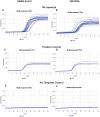A rapid, specific, extraction-less, and cost-effective RT-LAMP test for the detection of SARS-CoV-2 in clinical specimens
- PMID: 35404944
- PMCID: PMC9000105
- DOI: 10.1371/journal.pone.0266703
A rapid, specific, extraction-less, and cost-effective RT-LAMP test for the detection of SARS-CoV-2 in clinical specimens
Abstract
In 2019 a newly identified coronavirus, designated as severe acute respiratory syndrome coronavirus 2 (SARS-CoV-2), has spread rapidly from the epicenter in Wuhan (China) to more than 150 countries around the world, causing the Coronavirus disease 2019 (COVID-19) pandemic. In this study, we describe an extraction-less method based on reverse transcriptase loop-mediated isothermal amplification (RT-LAMP) intended for the rapid qualitative detection of nucleic acid from SARS-CoV-2 in upper respiratory specimens, including oropharyngeal and nasopharyngeal swabs, anterior nasal and mid-turbinate nasal swabs, nasopharyngeal washes/aspirates or nasal aspirates as well as bronchoalveolar lavage (BAL) from individuals suspected of COVID-19 by their healthcare provider. The assay's performance was evaluated and compared to an RT quantitative PCR-based assay (FDA-approved). With high sensitivity, specificity, and bypassing the need for RNA extraction, the RT-LAMP Rapid Detection assay is a valuable and fast test for an accurate and rapid RNA detection of the SARS-CoV-2 virus and potentially other pathogens. Additionally, the versatility of this test allows its application in virtually every laboratory setting and remote location where access to expensive laboratory equipment is a limiting factor for testing during pandemic crises.
Conflict of interest statement
The Prime Covid DetectTM Rapid Detection Assay is offered as a catalog item at Prime Discoveries Inc. The pipeline used for the SARS-CoV-2 detection in clinical samples using an RNA-extraction less protocol and RT-LAMP (Prime Covid DetectTM Rapid Detection Assay) is part of the patent application number 63/185,571 “An isothermal amplification system and method of use of the same for detecting pathogenic infection in a subject” (patent status: pending). The Prime Covid DetectTM Rapid Detection kit (cat# PRDICOV Prime Discoveries) is registered as In Vitro Medical Device in the European Union - CE approval (Certificate number: 2022-IVD/CE356). None of the points above alter the authors’ adherence to PLOS One policies on sharing data and materials.
Figures
Similar articles
-
Development and Clinical Application of a Rapid and Sensitive Loop-Mediated Isothermal Amplification Test for SARS-CoV-2 Infection.mSphere. 2020 Aug 26;5(4):e00808-20. doi: 10.1128/mSphere.00808-20. mSphere. 2020. PMID: 32848011 Free PMC article.
-
Comparison of COVID-19 laboratory diagnosis by commercial kits: Effectivity of RT-PCR to the RT-LAMP.J Med Virol. 2022 May;94(5):1998-2007. doi: 10.1002/jmv.27559. Epub 2022 Jan 21. J Med Virol. 2022. PMID: 34997587 Free PMC article.
-
Development of a multiplex Loop-Mediated Isothermal Amplification (LAMP) assay for on-site diagnosis of SARS CoV-2.PLoS One. 2021 Mar 3;16(3):e0248042. doi: 10.1371/journal.pone.0248042. eCollection 2021. PLoS One. 2021. PMID: 33657176 Free PMC article.
-
Loop-mediated isothermal amplification (LAMP): An effective molecular point-of-care technique for the rapid diagnosis of coronavirus SARS-CoV-2.Rev Med Virol. 2021 Nov;31(6):e2215. doi: 10.1002/rmv.2215. Epub 2021 Jan 21. Rev Med Virol. 2021. PMID: 33476080 Free PMC article. Review.
-
Evaluation of RT-LAMP Assay for Rapid Detection of SARS-CoV-2.Lab Med. 2023 Jan 5;54(1):56-64. doi: 10.1093/labmed/lmac030. Lab Med. 2023. PMID: 35849098 Free PMC article.
Cited by
-
Screening COVID-19 by Swaasa AI platform using cough sounds: a cross-sectional study.Sci Rep. 2023 Oct 25;13(1):18284. doi: 10.1038/s41598-023-45104-4. Sci Rep. 2023. PMID: 37880351 Free PMC article.
-
A quantitative RT-qLAMP for the detection of SARS-CoV-2 and human gene in clinical application.Microb Biotechnol. 2022 Oct;15(10):2619-2630. doi: 10.1111/1751-7915.14112. Epub 2022 Jul 13. Microb Biotechnol. 2022. PMID: 35830452 Free PMC article.
-
Quantitative mRNA expression measurement at home.Sci Rep. 2024 Jan 10;14(1):1013. doi: 10.1038/s41598-023-49651-8. Sci Rep. 2024. PMID: 38200031 Free PMC article.
-
Laboratory-based molecular test alternatives to RT-PCR for the diagnosis of SARS-CoV-2 infection.Cochrane Database Syst Rev. 2024 Oct 14;10(10):CD015618. doi: 10.1002/14651858.CD015618. Cochrane Database Syst Rev. 2024. PMID: 39400904
-
Development and Validation of Rapid Colorimetric Reverse Transcription Loop-Mediated Isothermal Amplification for Detection of Rift Valley Fever Virus.Adv Virol. 2023 Jan 30;2023:1863980. doi: 10.1155/2023/1863980. eCollection 2023. Adv Virol. 2023. PMID: 36755743 Free PMC article.
References
-
- Chan JF, Yuan S, Kok KH, To KK, Chu H, Yang J, et al.. A familial cluster of pneumonia associated with the 2019 novel coronavirus indicating person-to-person transmission: a study of a family cluster. Lancet. 2020;395(10223):514–23. Epub 20200124. doi: 10.1016/S0140-6736(20)30154-9 . - DOI - PMC - PubMed
-
- Hui DS, E IA, Madani TA, Ntoumi F, Kock R, Dar O, et al.. The continuing 2019-nCoV epidemic threat of novel coronaviruses to global health—The latest 2019 novel coronavirus outbreak in Wuhan, China. Int J Infect Dis. 2020;91:264–6. Epub 20200114. doi: 10.1016/j.ijid.2020.01.009 . - DOI - PMC - PubMed
MeSH terms
Substances
Supplementary concepts
LinkOut - more resources
Full Text Sources
Medical
Molecular Biology Databases
Miscellaneous





